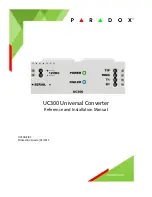
3. Operation
3-1. Turning the inverter on
Adjust the DIP switch setting to the mode you wish first, then turn the inverter on. The
buzzer beeps immediately, the inverter will go through a self-diagnosis, if there is
nothing wrong, the inverter will beep again and the Status Led will become green. The
inverter is now ready to deliver AC power to your loads.
If there are several loads in use, turn them on separately after the inverter has been
turned “ON” in order to prevent the OVP caused by the power surge.
3-2. Turning the inverter off
Set the main switch to the OFF position, the inverter output turns off and the LED goes off.
3-3. Remote Controller operation
Make sure the main switch is in the “off” position.
Connect the remote controller to the inverter.
Turn the Main switch to remote control position.
Turn the remote switch “on” or “off” to control the inverter operation or not.
Protection and troubleshooting
1. Battery low voltage
Alarm/protection Signals
Battery voltage Trouble shooting
Low voltage alarm Input level Led flashing slowly
buzzer beeps
21.2/42.0 V
Charge battery or
check the
conductor
connection
Low voltage shut
down
Input Level Led and status led
become red, slow flashing
20.6/41.2 V
When the input voltage raises to 25.6/51.2 V, the inverter will reconnect automatically and
resume operation.
2. Battery high voltage
Alarm/protection Signals
Battery voltage Trouble shooting
High voltage alarm Input level led flashing quickly 29.0/56.8 V
Check the battery
High voltage shut
down
Input Level Led and status led
become red and flashing
quickly
31.6/61.2 V
When the input voltage goes below 29.0/58.0 V, the inverter will reconnect automatically
and resume operation.
25
ENG
All manuals and user guides at all-guides.com
















































